
Asia | Economics & Growth | Emerging Markets

Asia | Economics & Growth | Emerging Markets
This article is only available to Macro Hive subscribers. Sign-up to receive world-class macro analysis with a daily curated newsletter, podcast, original content from award-winning researchers, cross market strategy, equity insights, trade ideas, crypto flow frameworks, academic paper summaries, explanation and analysis of market-moving events, community investor chat room, and more.
The India bull case is clear. India has become the most populous nation on Earth, and its population is expected to keep growing. Meanwhile, China’s population is shrinking. It is no wonder Indian growth has consistently topped the global charts. This year, India is expected to deliver the highest growth rate across emerging economies at 7%. Second place is Bangladesh at 6.5%, and third is Vietnam at 6.2%. China is expected to grow at 5.2%.
Moreover, India is undergoing major structural reforms. Most notably, the government has embarked on a dramatic digital transformation. The e-RUPI programme allows the public to receive welfare payments using a simple phone and without a bank account. This has reduced corruption as it removes humans from the distribution of government payments.
Another sign of digitalisation is the immediate release of the Union Budget in a government app. The public could therefore see the fiscal plan at the same time as reporters and economists.
Elsewhere, structural improvement comes via the steady increase in road building to help improve the country’s infrastructure. In 2015, India was building around 12km of highway a day, but by fiscal year 2021/22 it has risen to 29km a day.
It is no wonder Indian stocks (MSCI) are up 70% in dollar terms over the past 10 years. This compares to emerging market (EM) stocks in aggregate, which are down 8%, and European stocks, up only 35% over the same period.
But while digitalisation and population growth are seductive themes, India has several challenges looming. Here are four that stand out:
It is true that India is expected to see continued population growth, but the share of the population that is working age appears to be plateauing. In 2000, the share was 60%, and in 2022 it reached 68%. Therefore, India enjoyed a working-age population growth dividend.
However, United Nations projections suggest this to be near the peak. So India will now rely on overall population growth to increase its working-age population rather than both population growth and an increasing share of the working age.
This means that while India enjoyed a 17% growth in the working-age population over the past 10 years, that rate will fall to 10% over the next decade. On a 20-year window the picture is starker. Over the past 20 years, India’s working-age population grew by 43%, but over the next 20 years it is expected to grow by only 15%.
As countries develop, we would expect female participation in the labour force to increase, but with India it has recently been falling.
As a share of men working, female participation has fallen from 38% in 2005 to 28% today. That is a 10-percentage point (ppt) decline. Bangladesh, meanwhile, has seen its share grow from 33% to 45% over the same period, and Pakistan’s has grown from 22% to 26%. Yet Vietnam’s current female participation of 87% dwarfs them all.
India lacks a large manufacturing base. It is skewed towards high-skilled workers and capital-intensive sectors like pharmaceuticals and chemicals. But India has struggled to shift its lower-skilled workers from the agriculture sector – the largest employment sector in India – to manufacturing.
Other Asian economies, such as China, Vietnam, and more recently Bangladesh have all made the transition. This has helped propel Bangladesh’s GDP per capita to the same level as India’s. Absent such a transition, India’s productivity may lag other Asian industrialisers.
A combination of its small, low-skilled manufacturing base and its import substitution model has seen India struggle to become part of the global supply chain. As a result, the trend of companies attempting to move away from reliance on China has seen Vietnam, Thailand, Malaysia and Singapore benefit rather than India.
India has also failed to join multi-lateral trade agreements. These include the Regional Comprehensive Economic Partnership (RCEP) and the Comprehensive and Progressive Agreement for Trans-Pacific Partnership (CPTPP) – Singapore, Malaysia, Vietnam, Japan, Australia and New Zealand are members of both.
While recent openings of Apple/Foxconn factories in India suggests a potential shift here, at this stage, much of the output is destined to stay in the Indian market. Moreover, Tata’s Apple factory in Hosur, which makes iPhone casings, has reportedly had a 50% failure rate in its output.
India’s move to centralisation could impede its development, especially if it reduces economic competition between states. On energy, India has benefited from cheap Russian oil, which is unlikely to continue in the long run. Then there are India’s twin fiscal and current account deficits, which could become problematic if India’s growth rate stumbles. Already, both foreign direct investment (FDI) and portfolio flows are moderating.
Overall, India will deliver strong growth in the coming years, and the bull case is strong. But challenges have started to emerge on the medium-term horizon.
Spring sale - Prime Membership only £3 for 3 months! Get trade ideas and macro insights now
Your subscription has been successfully canceled.
Discount Applied - Your subscription has now updated with Coupon and from next payment Discount will be applied.